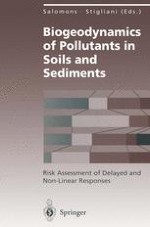1995 | OriginalPaper | Buchkapitel
Heavy Metal Retention by Soil Organic Matter under Changing Environmental Conditions
verfasst von : R. Schulin, G. Geiger, G. Furrer
Erschienen in: Biogeodynamics of Pollutants in Soils and Sediments
Verlag: Springer Berlin Heidelberg
Enthalten in: Professional Book Archive
Aktivieren Sie unsere intelligente Suche, um passende Fachinhalte oder Patente zu finden.
Wählen Sie Textabschnitte aus um mit Künstlicher Intelligenz passenden Patente zu finden. powered by
Markieren Sie Textabschnitte, um KI-gestützt weitere passende Inhalte zu finden. powered by
Impacts of human activities, which lead to a sudden, catastrophic event after a long period of delay, range among the most critical environmental problems. The algal blooms in the Adriatic Sea, or the stratospheric ozone losses are only two examples of such events for which the term “chemical time bomb” (CTB) has been coined. Continuous accumulation of pollutants in the environment from anthropogenic sources has to be recognized as the cause. With respect to soils and sediments, Stigliani et al. (1991) have defined a CTB as “a concept that refers to a chain of events, resulting in the delayed and sudden occurrence of harmful effects due to the mobilization of chemicals stored in soils and sediments in response to slow alterations to the environment”. It should be noted that chemicals which are mobilized are not necessarily man-made, but can also have a natural source. Aluminum e.g., the third most abundant element in the earth’s crust, is mobilized in soil only under acidic conditions. It is supposed, however, that the environmental alterations resulting in the mobilization of these chemicals are driven by human activities. Finally, the term “sudden” has to be understood with respect to the time scales of environmental changes and of possible political or operational reactions and countermeasures.
